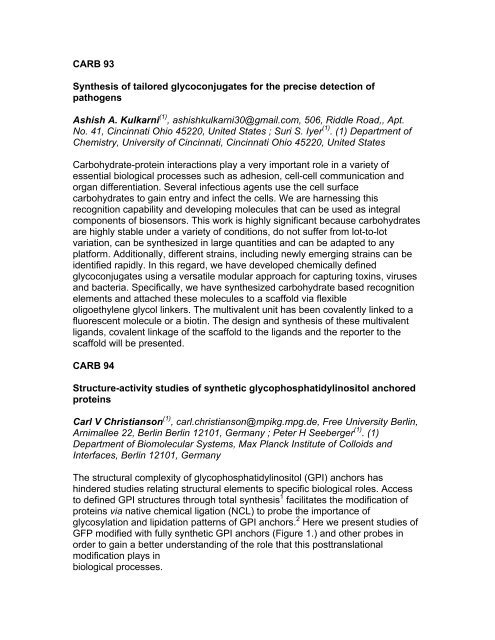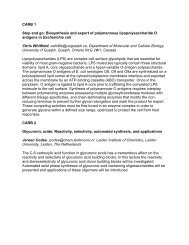American Chemical Society - Division of Carbohydrate Chemistry ...
American Chemical Society - Division of Carbohydrate Chemistry ...
American Chemical Society - Division of Carbohydrate Chemistry ...
You also want an ePaper? Increase the reach of your titles
YUMPU automatically turns print PDFs into web optimized ePapers that Google loves.
CARB 93<br />
Synthesis <strong>of</strong> tailored glycoconjugates for the precise detection <strong>of</strong><br />
pathogens<br />
Ashish A. Kulkarni (1) , ashishkulkarni30@gmail.com, 506, Riddle Road,, Apt.<br />
No. 41, Cincinnati Ohio 45220, United States ; Suri S. Iyer (1) . (1) Department <strong>of</strong><br />
<strong>Chemistry</strong>, University <strong>of</strong> Cincinnati, Cincinnati Ohio 45220, United States<br />
<strong>Carbohydrate</strong>-protein interactions play a very important role in a variety <strong>of</strong><br />
essential biological processes such as adhesion, cell-cell communication and<br />
organ differentiation. Several infectious agents use the cell surface<br />
carbohydrates to gain entry and infect the cells. We are harnessing this<br />
recognition capability and developing molecules that can be used as integral<br />
components <strong>of</strong> biosensors. This work is highly significant because carbohydrates<br />
are highly stable under a variety <strong>of</strong> conditions, do not suffer from lot-to-lot<br />
variation, can be synthesized in large quantities and can be adapted to any<br />
platform. Additionally, different strains, including newly emerging strains can be<br />
identified rapidly. In this regard, we have developed chemically defined<br />
glycoconjugates using a versatile modular approach for capturing toxins, viruses<br />
and bacteria. Specifically, we have synthesized carbohydrate based recognition<br />
elements and attached these molecules to a scaffold via flexible<br />
oligoethylene glycol linkers. The multivalent unit has been covalently linked to a<br />
fluorescent molecule or a biotin. The design and synthesis <strong>of</strong> these multivalent<br />
ligands, covalent linkage <strong>of</strong> the scaffold to the ligands and the reporter to the<br />
scaffold will be presented.<br />
CARB 94<br />
Structure-activity studies <strong>of</strong> synthetic glycophosphatidylinositol anchored<br />
proteins<br />
Carl V Christianson (1) , carl.christianson@mpikg.mpg.de, Free University Berlin,<br />
Arnimallee 22, Berlin Berlin 12101, Germany ; Peter H Seeberger (1) . (1)<br />
Department <strong>of</strong> Biomolecular Systems, Max Planck Institute <strong>of</strong> Colloids and<br />
Interfaces, Berlin 12101, Germany<br />
The structural complexity <strong>of</strong> glycophosphatidylinositol (GPI) anchors has<br />
hindered studies relating structural elements to specific biological roles. Access<br />
to defined GPI structures through total synthesis 1 facilitates the modification <strong>of</strong><br />
proteins via native chemical ligation (NCL) to probe the importance <strong>of</strong><br />
glycosylation and lipidation patterns <strong>of</strong> GPI anchors. 2 Here we present studies <strong>of</strong><br />
GFP modified with fully synthetic GPI anchors (Figure 1.) and other probes in<br />
order to gain a better understanding <strong>of</strong> the role that this posttranslational<br />
modification plays in<br />
biological processes.




